![]()
![]()
![]()
Use LEFT and RIGHT arrow keys to navigate between flashcards;
Use UP and DOWN arrow keys to flip the card;
H to show hint;
A reads text to speech;
46 Cards in this Set
- Front
- Back

|
Polet Chapel, S. Luigi dei Francesi, Rome, frescoes by Domenichino Domenichino, St. Cecilia Distributing Alms, 1612-15 (Domenechino follower of Carraci, admired Annibale in Rome, wanted to be anti-Caravaggio, SAME CHURCH AS ST MATHEW PICS, Domenichino basically pissing on the Caravaggios near him) "reveal with light, don't hide in shadow" Used Raphael's St. Cecilia w/weird topknot, used as lineage to show his authority comes from Raphael and Annibale. |
|
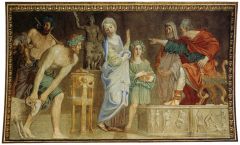
|
Polet Chapel, S. Luigi dei Francesi, Rome, frescoes by Domenichino Domenichino, St. Cecilia before the Judge, 1612-15 *used historically accurate objects, clear story told in one picture. *avoided shadow, makes shallow compositions in light, again to oppose Caravaggio's black images that were so realistic you couldn't always tell their meaning |
|
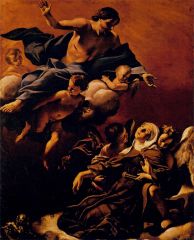
|
Giovanni Lanfranco, Ecstasy of Saint Margaret of Cortona,1622(Palazzo Pitti, Florence) Domenichino's rival, followed Annibale's Bolognese style, also referencing Correggio in soft tones |
|

|
Church of Sant’Andrea della Valle, Rome Domenichino, Calling of Saints Peter and Andrew, choir, 1625-28 |
|

|
Church of Sant’Andrea della Valle, Rome Domenichino, St. John, pendentive, 1627-28 looks small but gigantic, took Dom forever to make; only had two paintings in three years, dome needed to be finished |
|
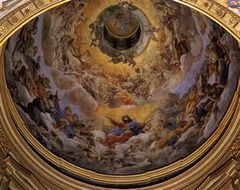
|
Church of Sant’Andrea della Valle, Rome Giovanni Lanfranco, Assumption of the Virgin, dome, 1625-27 |
|

|
Guido Reni, Crucifixion of St. Peter, 1604-5(Pinacoteca Vaticana) Only Caravaggestic picture; Caravaggio threatened him to a duel if he tried again |
|
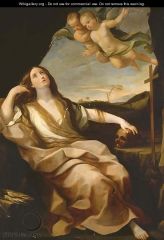
|
Guido Reni, The Penitent Magdalene, 1633(Galleria Nazionale d’Arte Antica, Rome) |
|
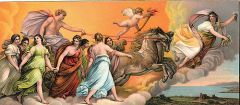
|
Guido Reni, Aurora, Casino Rospigliosi, Rome, 1613-1614 |
|
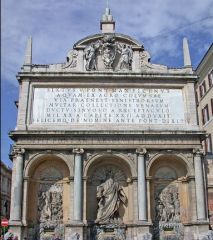
|
Domenico Fontana, Leonardo Bresciano, and Prospero Sormani: AcquaFelice fountain (Piazza S. Bernardo, Rome), 1589 Ugly, righteous D&D dwarf with great legs; also glorification of popes, also glorification of Pope Sixtus V and his aqueduct |
|
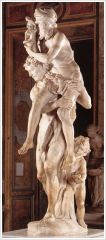
|
Gianlorenzo Bernini, Aeneas, Anchises, and Ascanius(Galleria Borghese, Rome), 1618-19 For Cardinal Borghese, the papal nephew/art thief; sculpture linked Borghese family to Roman origins. Was mostly Bernini showing off to get more known. |
|
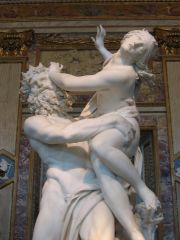
|
Gianlorenzo Bernini, Abduction of Proserpina(Galleria Borghese, Rome), 1622-4 Young Bernini, still for Cardinal Borghese |
|
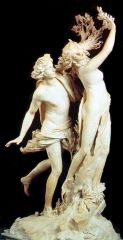
|
Gianlorenzo Bernini, Apollo and Daphne(Galleria Borghese, Rome), 1622-4 |
|

|
Gianlorenzo Bernini, David (Galleria Borghese, Rome), 1623-4 |
|
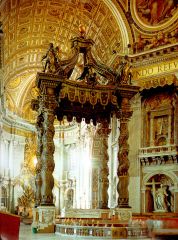
|
Gianlorenzo Bernini, Baldacchino, St. Peter’s, Rome, 1624-33 |
|
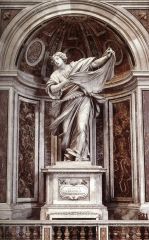
|
Francesco Mochi, St. Veronica (St. Peter’s Rome), 1629-32 |
|
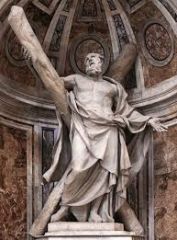
|
François Duquesnoy, St. Andrew (St. Peter’s Rome), 1629-40 |
|
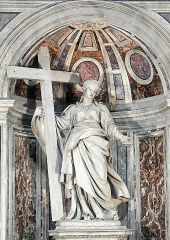
|
Andrea Bolgi, St. Helen (St. Peter’s Rome), 1630-39 |
|
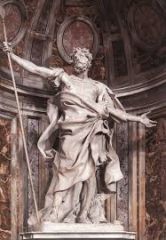
|
Gianlorenzo Bernini, St. Longinus (St. Peter’s Rome), 1629-38 |
|
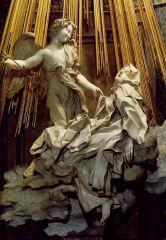
|
Gianlorenzo Bernini, Cornaro Chapel, S. Maria della Vittoria, Rome, 1645-52 Ecstasy of St Theresa (entire chapel designed as bel composto, hidden window above statue to give it hidden light, first time someone tried to carve light) Surrounded by carved members of Cornaro family |
|
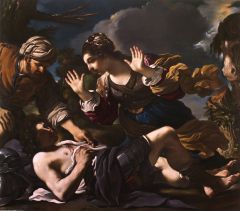
|
Guercino ("Squint eye") (Giovanni Barbieri), Erminia Discovering the Wounded Tancred, 1618 Bolognese artist, self-taught but inspired by Ludovico Carraci (so Bolognese style) |
|
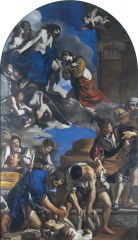
|
Guercino ("Squint eye"), Burial and Reception into Heaven of St. Petronilla, (for St. Peter’s, Rome), 1622 Style changed after he went to Rome due to the brief reign of a Bolognese pope; he was still given highest honor, altar piece in St. Peter's) Combined Caravaggestic realism with Carracci imagination) |
|

|
Villa Ludovisi, Rome Guercino, Fame with Honor and Virtue, 1621 |
|

|
Villa Ludovisi, Rome Guercino (and Agostino Tassi), Aurora, 1621–1623 |
|
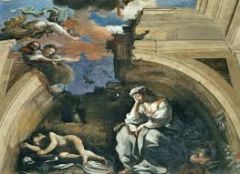
|
Villa Ludovisi, Rome Guercino, Night, 1621–1623, lunette fresco |
|
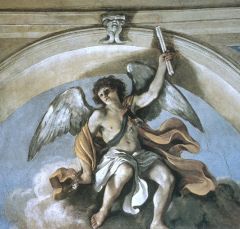
|
Villa Ludovisi, Rome Guercino, Day, 1621–1623, lunette fresco |
|
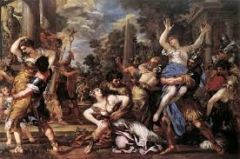
|
Pietro da Cortona, Abduction of the Sabine Women,1627-29 |
|
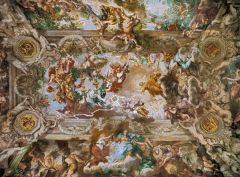
|
Pietro da Cortona, Glorification of the Reign of Urban VIII (Allegory of Divine Providence), Sala Grande, Palazzo Barberini, Rome, 1633-39 |
|
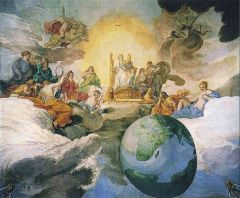
|
Andrea Sacchi, Allegory of Divine Wisdom, Palazzo Barberini, Rome, 1629-30 |
|
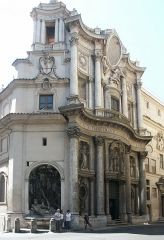
|
Francesco Borromini, S. Carlo alle Quattro Fontane (S. Carlino), Rome, 1638-67 |
|
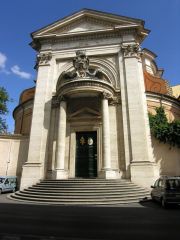
|
Gianlorenzo Bernini, S. Andrea al Quirinale, Rome, 1658-70 *compare to S. Carlo alle Quattro by Borromini; inside has a similar honeycomb dome and altar |
|

|
Gianlorenzo Bernini, Four Rivers Fountain, Piazza Navona, Rome, 1648-51 Rivers represented in allegory; made for Pope Innocent X? |
|
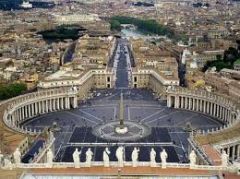
|
Gianlorenzo Bernini, Piazza San Pietro (St. Peter’s Square), Rome (1656-1667 Pope Alexander VII |
|
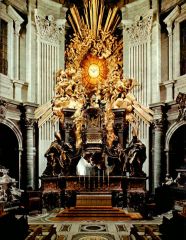
|
Gianlorenzo Bernini and workshop, Saint Peter’s Throne (Cathedra Petri), 1657-1666, St. Peter’s Rome Pope Alexander VII; wanted to top previous St. Peter's stuff; made Baldacchino into a frame for this, turned St. Peter's into bel composto |
|
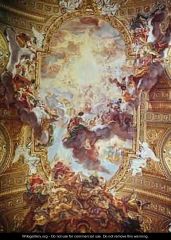
|
Giovanni Battista Gaulli, Triumph of the Name of Jesus, Church of Il Gesù, Rome, 1676-79 Peacock descending with sinners into hell. |
|

|
Andrea Pozzo, dome, Sant’Ignazio, Rome, c. 1685 |
|
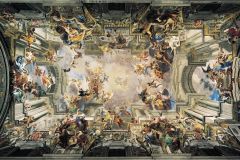
|
Andrea Pozzo, Allegory of the Missionary Work of the Jesuits (Triumph of Saint Ignatius of Loyola), Sant’Ignazio, Rome, 1691-4 |
|

|
Jusepe de Ribera,St. Jerome, 1626 (Naples, Museo di Capodimonte Compare to Orazio's St. Jerome |
|
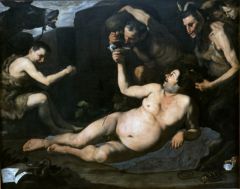
|
Jusepe de Ribera, Drunken Silenus, 1626 (Naples, Museo di Capodimonte "More Caravaggio than Caravaggio", ultra-realism, but still was able to realistically do movement and fantasy |
|
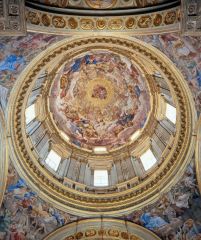
|
Cappella del Tesoro di San Gennaro (Chapel of the Treasury of San Gennaro, Naples): frescoes by Domenichino (and Giovanni Lanfranco), 1631-41 (Domenichino had his life threatened, escaped, came back, was poisoned) |
|
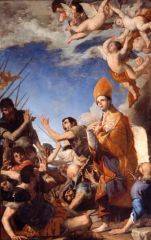
|
Jusepe de Ribera,San Gennaro Emerging Unharmed from the Furnace, 1641-43 |
|
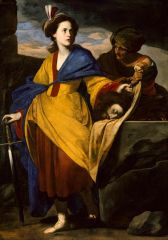
|
Massimo Stanzione, Judith with the Head of Holofernes, 1631 (New York, Metropolitan Museum of Art) Originally attributed to Artemisia Gentileschi but the face is different and the pose is softer, more focus on ideal beauty |
|
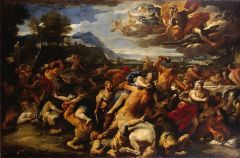
|
Luca Giordano, The Battle of the Lapiths and the Centaurs, 1688 (Hermitage, St. Petersburg) |
|
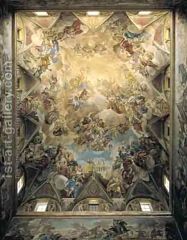
|
Luca Giordano, Triumph of the Spanish Hapsburgs, 1692-94, Imperial Staircase, El Escorial, Spain Made while the Spanish throne was ruled by a mad, inbred king and France was gaining power |
|
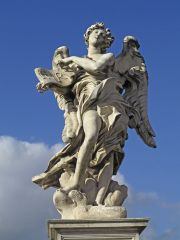
|
Gian Lorenzo Bernini and Giulio Cartari, Angel with the Superscription, Ponte Sant’Angelo, Rome, 1667-70 |
|
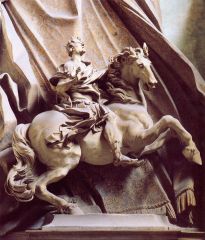
|
Gian Lorenzo Bernini, Equestrian Statue of Constantine, St. Peter’s, Rome, 1670 |

